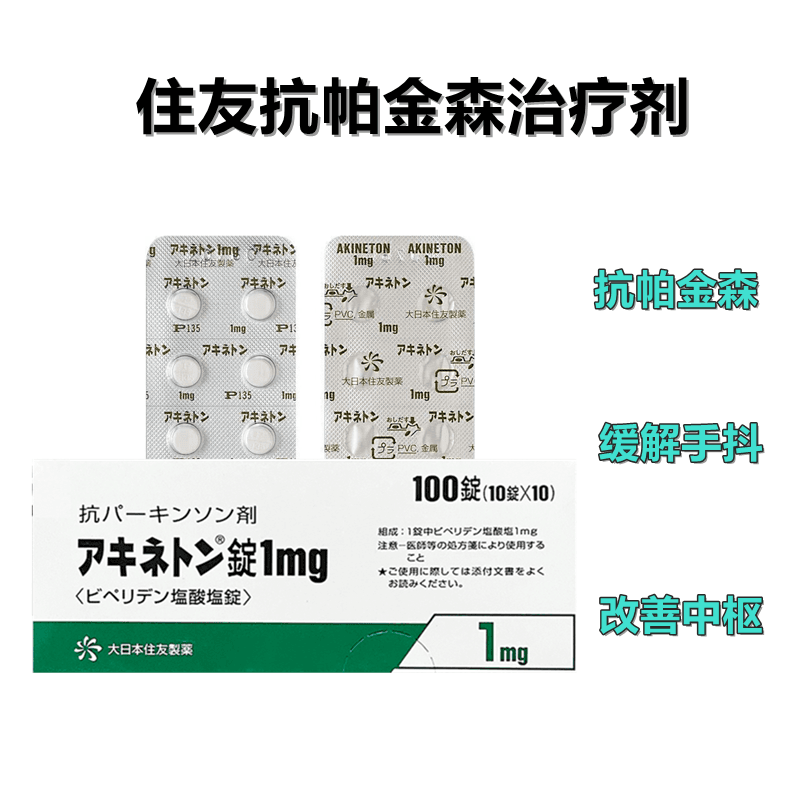Parkinson’s disease is a neurological disorder commonly seen in the elderly. Its causes are complex, but it is mainly associated with aging and the gradual decline of bodily functions. Today, a wide range of effective medications are available worldwide to help patients alleviate symptoms and improve their quality of life. In Asia in particular, Parkinson’s medications produced in Japan are highly regarded for their remarkable efficacy. In this article, we will introduce a Japanese-imported treatment for Parkinson’s disease that has been widely trusted by patients and physicians alike.

?? Japan Parkinson’s Medication|Akineton Tablets 1mg (Biperiden Hydrochloride Tablets)
✅ Product Name
Akineton Tablets 1mg (Biperiden Hydrochloride Tablets)
✅ Specification
Tablet form, 100 tablets per bottle
✅ Main Effects
Acts on the central nervous system to improve common symptoms of Parkinson’s disease, such as:
Hand tremors
Muscle stiffness
Slowness of movement
✅ Indications
Mainly used for the treatment of Parkinson’s disease.
✅ Dosage and Administration
Adults: Start with 1 tablet twice daily.
Maintenance dose: 3–6 tablets per day divided into several doses.
Dosage should be adjusted based on age and symptoms.
⚠️ This medication should be started at a low dose, with careful monitoring of tolerability, then gradually increased to the maintenance dose. When switching from other medications to this one, the other drugs should be tapered while this medication is increased.
✅ Ingredients and Excipients
Each tablet contains:
Biperiden Hydrochloride 1mg
Excipients: Crystalline cellulose, corn starch, hydrogenated oil, light anhydrous silicic acid, magnesium stearate
✨ Japan’s Parkinson’s medicine, primarily for treating Parkinson’s syndrome. Provides absolute symptom control and remarkable efficacy! Highly recommended by Japanese physicians, with excellent patient feedback.
✔️ Recommended Dosage:
Start with 1 tablet twice daily.
After one week, increase to 1–2 tablets three times daily.
Precautions
Main side effects: rash and liver damage (general fatigue, loss of appetite, nausea). If you notice any of these symptoms, please consult a doctor or pharmacist.
In rare cases, sudden fever, muscle stiffness, and tremors in the limbs (malignant syndrome) may occur. In such cases, stop using the medication immediately and seek medical attention.
Dependency: It may be difficult to stop using this medication (dependency).
I. How to Treat Parkinson's Disease?
Medication Treatment
In the early stages of Parkinson’s disease, medication can effectively improve symptoms. The most commonly used drugs are levodopa preparations, which help patients regain some motor function.
However, it is important to note that levodopa usually requires long-term use. Once the medication is stopped, symptoms tend to relapse easily. Although the drug effect is very noticeable at the beginning of treatment, the duration of its action gradually shortens over time. Typically, after 3 to 5 years of treatment, the condition may become harder to control, and drug-related side effects may also appear.
Surgical Treatment
When medication treatment is not ideal, surgical treatment can be an option. The commonly used surgical methods currently include:
Neural nucleus lesion surgery
Deep brain stimulation (DBS) surgery
These surgical methods can improve symptoms and help enhance the patient’s quality of life.
II. How to Care for Parkinson’s Patients
Pay attention to nutritional diet
Besides taking medication on time, Parkinson’s patients should also focus on balanced nutrition. The diet should be tailored according to the patient's age and activity level, providing enough total calories. Animal fat intake should be minimized. Protein is essential but intake should be controlled. It is appropriate to eat some seafood, which can provide high-quality protein and unsaturated fatty acids.
Enhance physical function training
Parkinson’s patients should not remain immobile in bed; they must persist in physical activities and actively exercise their limbs. This includes moving all joints in the limbs through maximum range of flexion, extension, and rotation to prevent muscle spasms and joint stiffness.
III. Parkinson's disease is a chronic illness with slow progression. In the early treatment phase, the main approach is controlling the condition with medication. Every patient hopes to control symptoms to the greatest extent possible. So, what precautions should Parkinson’s patients be aware of when taking medication?
Take medication on time.
Understand the effects of the medication as much as possible.
Persist with the treatment.
Consult a doctor before switching or stopping medication.
Always keep an adequate supply of medication on hand.
Although Parkinson’s disease currently cannot be cured, through scientific and standardized medication treatment and necessary surgical intervention, most patients can maintain a good quality of life. At any stage of the disease, regular medication, a positive mindset, and continuous rehabilitation exercises are key to living well with Parkinson’s.
